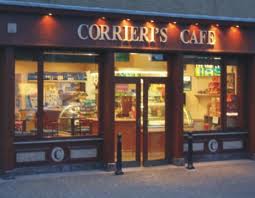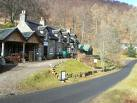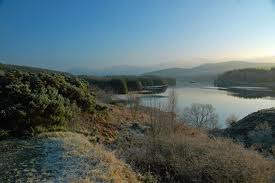Great cycling cafes in Scotland
Recently “Cycling Plus” magazine did a feature on some the best cycling cafes in the UK. Unfortunately there were none featured from Scotland, so to remedy that here is a list of some of the best I have been to. This list is not exhaustive and certainly only our opinion. We all have our favourite places to stop, so leave a comment below with your favourite.
 Corrieri’s Cafe – Stirling. Owned by the Tuscan Corrieri family for over 40 years, this cafe is a regular haunt by cyclists. The pile of bikes outside on a Sunday is testimony to this cafe’s popularity with cyclists. Corrieri’s also sponsor an early season TT and inside paintings of the “Golden Age” of cycling adorn the walls, including a stunning picture of Fausto Coppi.
Corrieri’s Cafe – Stirling. Owned by the Tuscan Corrieri family for over 40 years, this cafe is a regular haunt by cyclists. The pile of bikes outside on a Sunday is testimony to this cafe’s popularity with cyclists. Corrieri’s also sponsor an early season TT and inside paintings of the “Golden Age” of cycling adorn the walls, including a stunning picture of Fausto Coppi.- Brid
 ge of Balgie Post Office – Glen Lyon. Possibly one of the most scenic cafe locations. Certainly one of the best rides to get to it. You can either ascend the four mile road that goes over the shoulder of Ben Lawers and drops into Glen Lyon. Or you can head up Glen Lyon from Fortingall. Either way, the cycling is top notch and the cafe provides a fantastic stopping off point to savour some of the best cycling in the UK.
ge of Balgie Post Office – Glen Lyon. Possibly one of the most scenic cafe locations. Certainly one of the best rides to get to it. You can either ascend the four mile road that goes over the shoulder of Ben Lawers and drops into Glen Lyon. Or you can head up Glen Lyon from Fortingall. Either way, the cycling is top notch and the cafe provides a fantastic stopping off point to savour some of the best cycling in the UK. - Katie’s tea room –
 Birnam. A regular haunt for Perth United CC and clubs from Dundee and further afield. Katie’s tea room is basic and simple, but cheap and tasty too. Perfect for a stop mid ride.
Birnam. A regular haunt for Perth United CC and clubs from Dundee and further afield. Katie’s tea room is basic and simple, but cheap and tasty too. Perfect for a stop mid ride. - Laggan Wolftrax – Laggan. Part of the Laggan forest MTB trails. the Wolftrax cafe is primarily
 for MTB riders, but just off the main Dalwhinne – FortWilliam road, provides an ideal stopping off point for road and touring cyclists. It has the benefit of a bike shop next door, as well as a bike wash facility, bike racks and the best off, stunning cheesy beans on toast. What more could you ask for?
for MTB riders, but just off the main Dalwhinne – FortWilliam road, provides an ideal stopping off point for road and touring cyclists. It has the benefit of a bike shop next door, as well as a bike wash facility, bike racks and the best off, stunning cheesy beans on toast. What more could you ask for? - Escape Route – Pitlochry.
 A bike and outdoor shop that has a small seating area indoors and outdoors. The shop sells fresh coffee and cold drinks and if you’re lucky you may get some homemade baking too. Bike wash and racks are all available too. Escape Route is the meeting point of several clubs in the area and the central point for a great number of cycling routes in Highland Perthshire. Inside the shop has a great selection of cycling gear that you can peruse.
A bike and outdoor shop that has a small seating area indoors and outdoors. The shop sells fresh coffee and cold drinks and if you’re lucky you may get some homemade baking too. Bike wash and racks are all available too. Escape Route is the meeting point of several clubs in the area and the central point for a great number of cycling routes in Highland Perthshire. Inside the shop has a great selection of cycling gear that you can peruse.  Debbie’s Cafe – Islay. Bruichladdich Mini-Market, known locally as Debbie’s, serves easily the finest designer coffees this side of Milan. It is also the start of the annual Ride of the Falling Rain and the approved coffee stop of Velo Club d’Ardbeg. Thanks to Baz for the info on this.
Debbie’s Cafe – Islay. Bruichladdich Mini-Market, known locally as Debbie’s, serves easily the finest designer coffees this side of Milan. It is also the start of the annual Ride of the Falling Rain and the approved coffee stop of Velo Club d’Ardbeg. Thanks to Baz for the info on this. The Hub Cafe – Glentress. Another one for the off-roaders. Thanks to Mark from www.bicycles.org.uk for highlighting this cafe. A great cafe, set amongst stunning trails with lots of stuff going on all year round. Well worth a visit.
The Hub Cafe – Glentress. Another one for the off-roaders. Thanks to Mark from www.bicycles.org.uk for highlighting this cafe. A great cafe, set amongst stunning trails with lots of stuff going on all year round. Well worth a visit.
Now it’s your turn. Let us know your favourite cycling cafe stops in Scotland.

 Corrieri’s Cafe
Corrieri’s Cafe  ge of Balgie Post Office
ge of Balgie Post Office Birnam. A regular haunt for Perth United CC and clubs from Dundee and further afield. Katie’s tea room is basic and simple, but cheap and tasty too. Perfect for a stop mid ride.
Birnam. A regular haunt for Perth United CC and clubs from Dundee and further afield. Katie’s tea room is basic and simple, but cheap and tasty too. Perfect for a stop mid ride. for MTB riders, but just off the main Dalwhinne – FortWilliam road, provides an ideal stopping off point for road and touring cyclists. It has the benefit of a bike shop next door, as well as a bike wash facility, bike racks and the best off, stunning cheesy beans on toast. What more could you ask for?
for MTB riders, but just off the main Dalwhinne – FortWilliam road, provides an ideal stopping off point for road and touring cyclists. It has the benefit of a bike shop next door, as well as a bike wash facility, bike racks and the best off, stunning cheesy beans on toast. What more could you ask for? A bike and outdoor shop that has a small seating area indoors and outdoors. The shop sells fresh coffee and cold drinks and if you’re lucky you may get some homemade baking too. Bike wash and racks are all available too. Escape Route is the meeting point of several clubs in the area and the central point for a great number of cycling routes in Highland Perthshire. Inside the shop has a great selection of cycling gear that you can peruse.
A bike and outdoor shop that has a small seating area indoors and outdoors. The shop sells fresh coffee and cold drinks and if you’re lucky you may get some homemade baking too. Bike wash and racks are all available too. Escape Route is the meeting point of several clubs in the area and the central point for a great number of cycling routes in Highland Perthshire. Inside the shop has a great selection of cycling gear that you can peruse.
 The Hub Cafe
The Hub Cafe Flavio Zappi rode as a professional cyclist in the early 1980s, wore the king of the mountains jersey in the Giro d’Italia and finished 12th in the 1984 Milan-San Remo Classic, which was won by Francesco Moser, before quitting cycling and concentrating on a career in the catering industry.
Flavio Zappi rode as a professional cyclist in the early 1980s, wore the king of the mountains jersey in the Giro d’Italia and finished 12th in the 1984 Milan-San Remo Classic, which was won by Francesco Moser, before quitting cycling and concentrating on a career in the catering industry.

 If you like your cycling to be packed with hills, then the Bealach Mor sportive is made just for you. For starters it features the ascent of the Bealach Na Ba pass on the Applecross peninsula; at 6 miles, the longest continuous road climb in the UK. Before that there are two other big climbs and to follow it a stunning rollercoaster of a road that packs in at least 20 short sharp climbs and descents into 25 miles.
If you like your cycling to be packed with hills, then the Bealach Mor sportive is made just for you. For starters it features the ascent of the Bealach Na Ba pass on the Applecross peninsula; at 6 miles, the longest continuous road climb in the UK. Before that there are two other big climbs and to follow it a stunning rollercoaster of a road that packs in at least 20 short sharp climbs and descents into 25 miles. The ascent of the Bealach is timed and riders are required to stop and swipe their timing cards at the bottom and top. The fastest ascent this year was posted by Dave Moran of the Edinburgh RC team at 32mins 29 secs. The climb starts by following the contours of the hillside slowly and steadily before entering the jaws of the corrie. As it does so it steepens noticeably and heads directly towards the hairpin bends at the lip of the corrie. The headwall is steep enough at this point to look down the snaking road and see riders battling with gravity directly below you. The feed station at the summit offers a short respite, for those who need to refuel and at this point for many it is advisable as the challenge has only just started.
The ascent of the Bealach is timed and riders are required to stop and swipe their timing cards at the bottom and top. The fastest ascent this year was posted by Dave Moran of the Edinburgh RC team at 32mins 29 secs. The climb starts by following the contours of the hillside slowly and steadily before entering the jaws of the corrie. As it does so it steepens noticeably and heads directly towards the hairpin bends at the lip of the corrie. The headwall is steep enough at this point to look down the snaking road and see riders battling with gravity directly below you. The feed station at the summit offers a short respite, for those who need to refuel and at this point for many it is advisable as the challenge has only just started.
 From the Cyclotoon website at
From the Cyclotoon website at 
